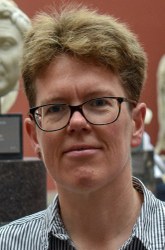Affiliation: University of Cambridge

Dr. Rebecca Flemming is Senior Lecturer in Ancient History in the Classics Faculty at the University of Cambridge, and a member of Jesus College. She holds her degrees from University College London (Ph.D.) and Trinity College Cambridge, and her research interests include the social and cultural history of the Roman Empire, ancient medicine and the history of disease, women and gender issues in the ancient and modern worlds, and Roman religion. Her recent publications include Medicine and Markets: Essays on Ancient Medicine in Honour of Vivian Nutton, (ed. with Laurence Totelin, Classical Press of Wales, 2020) and Reproduction: Antiquity to the Present Day, (ed. withNick Hopwood and Lauren Kassell (Cambridge University Press, 2018). Dr. Flemming is an AIA Joukowsky Lecturer for 2020/2021.
Tens of thousands of votive objects, mostly in terracotta, survive from religious sanctuaries across Republican central Italy (from the fourth to the first centuries BC). Many are in the shape of body parts, external and internal, single and multiple, even displayed within a whole human torso or figure, and they are usually interpreted as representing engagements with the divine about health and healing, broadly construed. They offer key insights into both religion in early Italy and ideas about the human body. This lecture first offers an overview of the extant material and the cult practice, the address and thanks to the gods, that these artefacts embody, summarizing both recent finds and new scholarship on the phenomenon of the anatomical ex-voto. The focus then turns to the ‘polyviscera’, the objects which depict multiple organs, in a range of presentational styles, and to the meanings they might have, both in terms of the ways the human body was understood in antiquity, and the ways divinities might be invited to intervene in it.
Short bibliography and/or website on lecture topic:
Jane Draycott and E.-J. Graham (eds), Bodies of Evidence: Ancient Anatomical Votives Past, Present and Future (London, 2017),
Jessica Hughes, Votive Body Parts in Greek and Roman Religion (Cambridge, 2017)
The Votives Project (https://thevotivesproject.org/)
************************************************************************
Lecture summary: Though modern studies of reproduction in the ancient Mediterranean world have tended to focus on possibilities of prevention or limitation, the main aim of individuals and families in antiquity was to have healthy children and keep them healthy in circumstances of very high infant mortality. Family continuity—the transmission of name and cult, identity and property—mattered to everyone, not just those with substantial patrimonies. This lecture explores the archaeological evidence for these generative endeavours in ancient Greece and Rome, from funerary inscriptions for midwives to votive wombs, infertility remedies to birthing amulets, foetal skeletal remains to feeding bottles. All stages in the procreative process—conception, pregnancy, birth, breastfeeding and infant care—made their impact on the material record, and that record reveals certain patterns in contemporary understanding and action, puts the emphasis on specific issues and interventions. Drawing all the material together demonstrates the high level of social and personal investment in producing and maintaining offspring, and raises interesting questions about agency and control.
Short bibliography and/or website on lecture topic (for lay reader):
Nick Hopwood, Rebecca Flemming and Lauren Kassell (eds), Reproduction: Antiquity to the Present Day (Cambridge: Cambridge University Press, 2018).